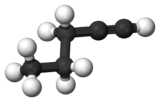1-Pentyne
Appearance

| |

| |
| Names | |
|---|---|
| Preferred IUPAC name
Pent-1-yne | |
| Other names
Propylacetylene
| |
| Identifiers | |
3D model (JSmol)
|
|
| ChEMBL | |
| ChemSpider | |
| ECHA InfoCard | 100.009.989 |
PubChem CID
|
|
| UNII | |
CompTox Dashboard (EPA)
|
|
| |
| |
| Properties | |
| C5H8 | |
| Molar mass | 68.12 |
| Appearance | colorless liquid |
| Density | 0.691 g/mL |
| Melting point | −106 to −105 °C |
| Boiling point | 40.2 °C (104.4 °F; 313.3 K) |
| Insoluble | |
| Hazards | |
| Occupational safety and health (OHS/OSH): | |
Main hazards
|
Flammable Liquid |
| Flash point | −20 °C (−4 °F; 253 K) |
Except where otherwise noted, data are given for materials in their standard state (at 25 °C [77 °F], 100 kPa).
| |
1-Pentyne is an organic compound with the formula CH3CH2CH2C≡CH. It is a terminal alkyne, in fact the smallest that is liquid at room temperature. The compound is a common terminal alkyne substrate in diverse studies of catalysis.[2][3]
See also
[edit]- 2-Pentyne, an isomer
References
[edit]- ^ 1-Pentyne at Sigma-Aldrich
- ^ Guimond, Nicolas; Gouliaras, Christina; Fagnou, Keith (2010). "Rhodium(III)-Catalyzed Isoquinolone Synthesis: The N−O Bond as a Handle for C−N Bond Formation and Catalyst Turnover". Journal of the American Chemical Society. 132 (20): 6908–6909. doi:10.1021/ja102571b. PMID 20433170.
- ^ Cassar, L. (1975). "Synthesis of aryl- and vinyl-substituted acetylene derivatives by the use of nickel and palladium complexes". Journal of Organometallic Chemistry. 93 (2): 253–257. doi:10.1016/s0022-328x(00)94048-8.
External links
[edit]
